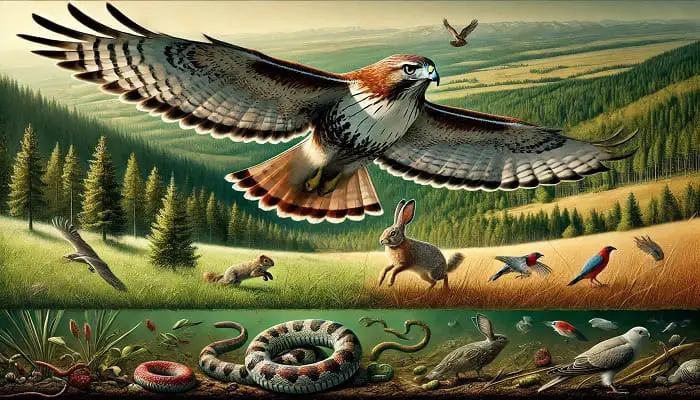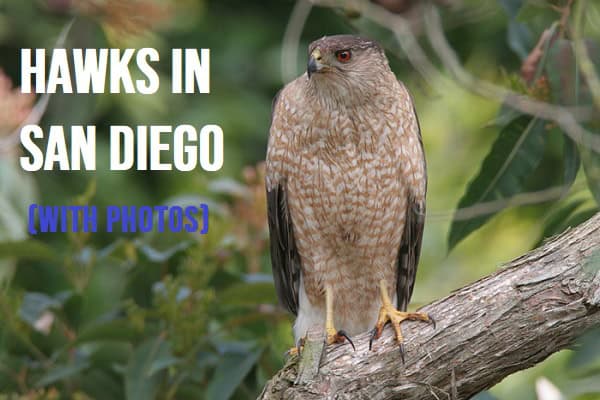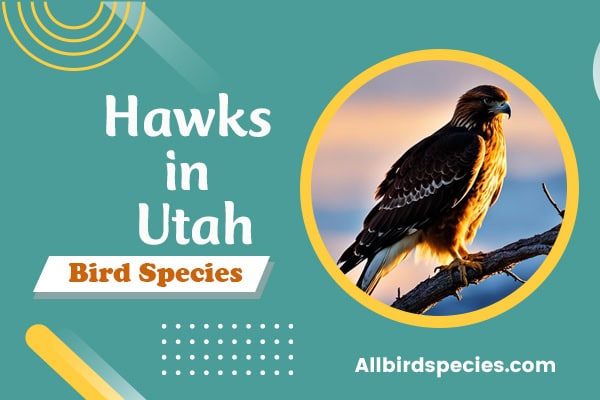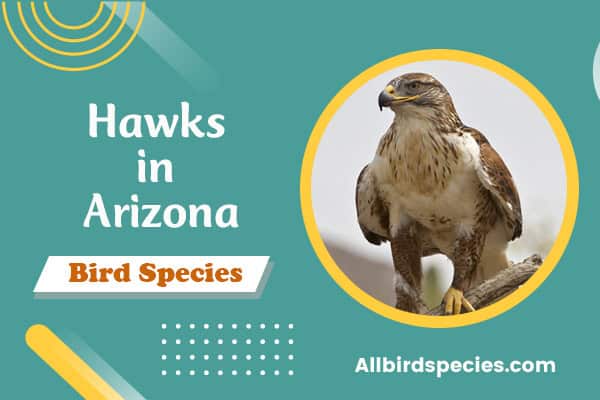What Do Hawks Eat? Unraveling the Diet of These Majestic Birds
Have you ever marveled at seeing a hawk soaring gracefully through the sky? But have you ever wondered what hawks eat? Understanding their diet reveals fascinating insights into their behavior and habitat. From small mammals to birds, these skilled hunters exhibit unique feeding strategies that leave us in awe. Let’s dive into the world of hawks and uncover what fuels these incredible creatures!
Red-tailed Hawk
The Red-tailed Hawk is one of the most recognizable birds in North America, known for its striking reddish-brown tail. These hawks are medium to large-sized raptors, often spotted perched on telephone poles or soaring high above open fields. Their adaptability allows them to thrive in various environments, from deserts to forests.
In terms of behavior, Red-tailed Hawks are solitary hunters. They rely heavily on their keen eyesight to spot prey from great heights. They swoop rapidly once they identify potential meals—rabbits and rodents being favorites.

Regarding feeding habits, these hawks hunt primarily during the day. They combine, sitting quietly and scanning their surroundings before swiftly moving towards unsuspecting prey below. Their impressive hunting skills make them top predators in many ecosystems.
Overview
Red-tailed Hawks are among the most recognizable birds of prey in North America. Their distinctive reddish-brown tail sets them apart from other hawks. These majestic creatures can be seen soaring high above fields and forests.
Adult Red-tailed Hawks typically weigh between 1.5 and 3.5 pounds and have wingspans up to four feet. Their size and strength make them formidable hunters.
Their diet is varied, allowing them to thrive in different environments. Red-tailed Hawks adapt their feeding habits from small mammals to birds based on availability and location.
Behavior
Hawks are fascinating creatures, often seen soaring gracefully in the sky. Their keen eyesight allows them to spot prey from high above. Once they lock onto their target, they dive down with incredible speed and precision.
These birds of prey are also known for their hunting tactics. They can be solitary hunters or collaborate in pairs when necessary. This flexibility helps them adapt to different environments and situations.
Social interactions among hawks can be quite interesting, too. During mating season, males wear aerial displays to attract females, showcasing their agility and strength while flying together.
Habitat
Hawks are adaptable birds that can thrive in various habitats. They are soaring over open fields, woodlands, and even urban areas. Their versatility is one of the reasons they’re so successful.
Red-tailed Hawks prefer areas with plenty of perches for hunting. They often choose tall trees or power lines to spot their prey from above. This vantage point is crucial for spotting small animals below.
In contrast, Cooper’s Hawks favor denser forests where they can navigate through branches more easily. Each species has unique habitat preferences that help them maximize their hunting success and survival rates.
Feeding Behavior
Hawks have a fascinating approach to feeding. They rely heavily on their keen eyesight to spot prey from great distances. Once they identify a target, it’s all about stealth and precision.
When hunting, they can swoop down with incredible speed and accuracy. Their sharp talons are designed for gripping and capturing their meals quickly, making them efficient predators in the wild.
Interestingly, hawks often choose different strategies based on the type of prey available. Some prefer to hunt alone, while others may join forces with fellow hawks during particularly abundant times or when tackling larger animals.
Cooper’s Hawk
Cooper’s Hawks are fascinating birds of prey. Known for their agility and speed, they often surprise unsuspecting birds at feeders. Their sharp eyesight helps them spot potential meals from afar.

These medium-sized hawks have long tails that aid in maneuvering through dense trees. They prefer wooded areas where they can easily hide and hunt. Watching one swoop down to catch its prey is truly an awe-inspiring sight.
Cooper’s Hawks have adapted well to urban environments, making their presence known even within city limits. Their ability to thrive in various habitats showcases their resilience as hunters.
Comparison with Other Hawks
Cooper’s hawks are often compared to other species, like the red-tailed hawk. While both are skilled hunters, their size and hunting techniques differ. Red-tailed hawks tend to be larger and prefer open habitats for soaring.
In contrast, Cooper’s hawks excel in wooded areas where they can maneuver quickly through trees. Their agility allows them to pursue smaller birds effectively.
This distinction highlights how each species has adapted its diet based on available prey and environment. Understanding these differences enriches our appreciation of their unique roles in the ecosystem.
Importance of Friends in Conservation
Hawks are incredible birds, but they can’t thrive in isolation. Their survival often depends on the ecosystems around them. That’s where friends come into play—both human and animal allies.
Collaborative conservation efforts make a real difference. Wildlife organizations work tirelessly to protect habitats that hawks rely on for hunting and nesting. When communities unite, they create awareness about the importance of preserving these majestic creatures.
Even other wildlife plays a role! A balanced ecosystem supports diverse prey species, ensuring that hawks have enough food to survive and flourish. Together, we can help maintain this delicate balance for generations to come.
Understanding Hawk Diets
Hawks are fascinating predators with diets that vary widely among species. Their adaptations help them hunt efficiently, ensuring they thrive in diverse habitats. Understanding what hawks eat provides insight into their role in the ecosystem.
Prey is crucial for survival; these birds typically feast on small mammals, birds, and insects. Based on size and availability, each type of hawk has its preferred menu items.
Feeding frequency can differ greatly depending on factors like prey abundance and energy needs. Some hawks might hunt daily while others may go several days without a meal after a successful catch.
Importance of Prey
Prey is the lifeblood of hawks. It fuels their incredible energy and supports their growth. These majestic birds struggle to thrive in the wild without a steady supply.
Different hawk species have unique preferences for prey. Some focus on small mammals, while others target birds or reptiles. This diversity helps maintain ecological balance by controlling populations.
Furthermore, healthy prey populations indicate a thriving ecosystem. When you see hawks soaring above, it’s a sign that nature’s web is intact and flourishing. Their diet truly reflects the health of their environment and our responsibility to protect it.
Frequency of Feeding
Hawks are fascinating creatures with diverse diets that vary depending on the species. They generally hunt and eat small mammals, birds, reptiles, and insects. Their feeding frequency largely depends on food availability and their energy needs.
Typically, hawks may eat daily or every few days if prey is scarce. They have remarkable hunting skills that allow them to catch their meals efficiently. Observing these majestic birds can give you a glimpse into the intricate balance of nature and the vital role these predators play in maintaining ecosystems.
Next time you spot a hawk soaring above or perched high in a tree, consider what do hawks eat as part of their daily routine—it’s quite an impressive endeavor!
Frequently Asked Questions About What Do Hawks Eat?
What do red hawks eat?
Red-tailed hawks primarily eat small mammals, birds, and reptiles like mice, rabbits, and squirrels.
Do hawks eat snakes?
Yes, hawks often eat snakes as part of their diet, especially in open fields and grasslands.
Do hawks eat bunnies?
Yes, hawks frequently hunt and eat rabbits, as they are a common prey item.
Do hawks eat ducks?
Yes, hawks can hunt and eat smaller ducks, especially young or injured ones.
Do hawks eat hummingbirds?
Though it’s rare, hawks may catch and eat hummingbirds if the opportunity arises.
What do hawk moths eat?
Adult hawk moths primarily feed on nectar from flowers.
Do hawks eat dead animals?
Yes, hawks may occasionally scavenge dead animals, though they prefer live prey.
Do hawks eat small dogs?
While rare, large hawks may attempt to attack very small dogs, but it’s uncommon.
Do hawks eat small birds?
Yes, hawks regularly prey on small birds as part of their diet.
Do hawks eat fruit?
No, hawks are carnivorous and do not eat fruit.
Do hawks eat bats?
Yes, some species of hawks may hunt and eat bats.
Do hawks eat worms?
Hawks do not typically eat worms; they prefer larger prey like small mammals and birds.
What do hawk moth caterpillars eat?
Hawk moth caterpillars feed on the leaves of various plants and trees.
Do hawks eat kittens?
It is rare, but large hawks may attack very young kittens if they are small enough.
Do hawks eat lizards?
Yes, hawks commonly hunt and eat lizards, especially in warmer climates.







